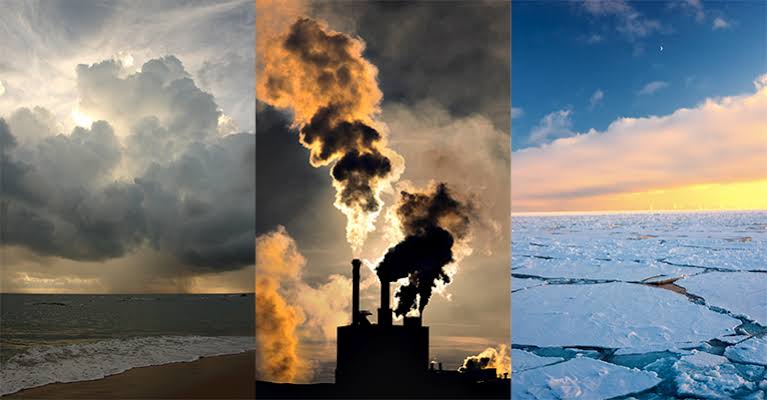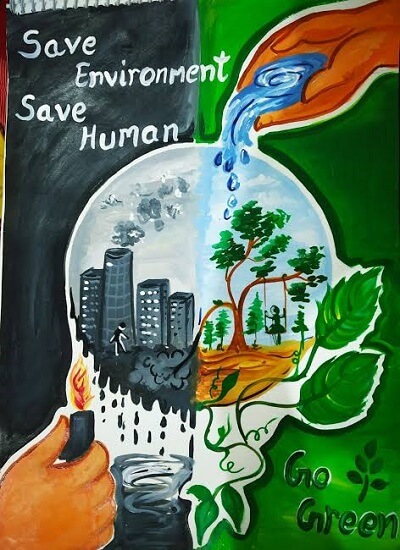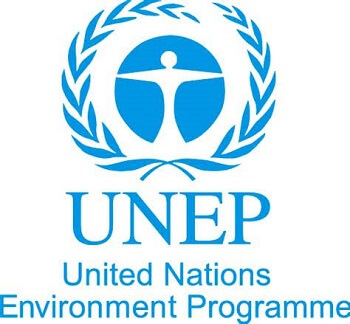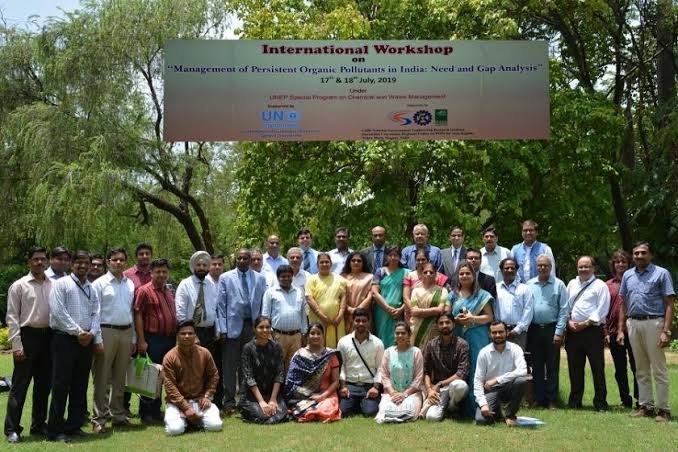Save Environment EssayThe environment includes all living and non-living objects that occur naturally, that is, not artificially. The phrase is most frequently used with reference to Earth or certain regions of it. The interactions between all living things, the climate, the weather, and the natural resources that influence human survival and economic activity are all included in this ecosystem. The following elements make up the idea of the natural environment:

Human Effects On The Environment
The term "human effect on the environment" (also known as "anthropogenic impact") describes modifications that humans either directly or indirectly make to biophysical environments, ecosystems, biodiversity, and natural resources. Global warming, environmental degradation (such as ocean acidification), mass extinction and biodiversity loss, ecological crises, and ecological collapse are all serious consequences of altering the environment to meet societal requirements. Global population expansion, excessive consumerism, overexploitation, pollution, and deforestation are some examples of human activities that harm the environment (directly or indirectly). It has been suggested that some of the issues, such as global warming and biodiversity loss, pose grave hazards to the existence of the human species. Ways To Save The EnvironmentThere are numerous small steps that people can take at home to help save the environment. While each step has a small environmental impact, thousands of people doing the same thing can make a difference. Even as an individual, you can make a difference by making small changes to how you do things at home. We have put together a few pointers, tricks, and ideas to get you started!

We should all be grateful for the beautiful environment in which we live. Instead of destroying it, we should concentrate on saving it. To save the environment, we must all work together and take action. There are several reasons to save the environment. Preventing the extinction of living organisms, preventing global warming, and protecting Mother Nature The presence of flora and fauna is critical for a healthy ecosystem. The extinction of flora and fauna is caused by deforestation and logging. Because everything is connected to everything else, we must keep everything in nature in order to maintain a balanced ecosystem. It is not only our duty, but it must also be our passion to clean up after Mother Nature. Unfortunately, technological advancements are driving us away from the environment. But we can't deny that no matter how wealthy we become, the environment will always be a necessity. When our environment is clean, our population becomes healthier. We can also easily save the environment by changing our daily routines. We must keep our surroundings clean and use paper bags rather than plastic bags. To protect our environment, we must plant more trees. The United Nations Environment Programme
The United Nations Environment Programme (UNEP) is in charge of coordinating environmental responses across the United Nations system. Maurice Strong, the organisation's first director, founded it following the United Nations Conference on the Human Environment in Stockholm in June 1972. Its mission is to provide leadership, deliver science, and develop solutions to a variety of issues, including climate change, marine and terrestrial ecosystem management, and green economic development. The organisation also creates international environmental treaties, publishes and promotes environmental science, and assists national governments in meeting environmental goals. UNEP's mission as a member of the United Nations Development Group is to assist the world in meeting the 17 Sustainable Development Goals. The United Nations Environment Programme (UNEP) hosts the secretariats of several multilateral environmental treaties and research organisations, including the Convention on Biological Diversity (CBD), the Minamata Convention on Mercury, the Convention on Migratory Species, and the Convention on International Trade in Endangered Species of Wild Fauna and Flora (CITES). The World Meteorological Organization and the United Nations Environment Programme established the Intergovernmental Panel on Climate Change in 1988. (IPCC). UNEP is also one of several Implementing Agencies for the Global Environment Facility (GEF) and the Multilateral Fund for Montreal Protocol Implementation (MFMI). The alternative term for UNEP is UN Environment. HistoryThe necessity for global environmental governance was not widely acknowledged in the 1970s, especially by developing countries. Some claimed that countries in poverty did not need to prioritise environmental issues. Many of the governments of developing nations were persuaded by Canadian diplomat Maurice Strong that this issue required priority. The United Nations Conference on the Human Environment (the Stockholm Conference) was held in 1972 following the development of organisations like the International Labor Organization, the Food and Agriculture Organization, and the World Health Organization. Diverse subjects, including pollution, marine life, resource protection, environmental change, and disasters related to natural and biological change, were covered during this conference. This conference led to the creation of the United Nations Environment Program and the Stockholm Declaration on the Human Environment, two organisations responsible for environmental management (UNEP). By General Assembly Resolution 2997, UNEP was created. With a team of 300, including 100 professionals in various sectors, the headquarters were formed in Nairobi, Kenya, and they have a five-year fund of more than US$100 million. At the time, the United States pledged $40 million, with the remaining $50 million coming from 50 other countries. Increased UNEP supporters were the goal of the 2002-established "Voluntary Indicative Scale of Contribution." The United Nations Member states voluntarily provide the money needed to support all of UNEP's operations. The main funding source for UNEP's initiatives is the Environmental Fund, to which all UNEP member countries contribute. More than 200 technical guidelines or guides on environmental topics, such as forest and water management, pest control, pollution monitoring, the connection between chemical usage and health, and management of industry, were created by UNEP between 1974 and 1986. Missions of UNEPThe goal of UNEP is to inspire, enlighten, and enable nations and peoples to improve their quality of life without compromising that of future generations in order to give leadership and promote collaboration in environmental protection. Area Of Concentration In Six AreasAs part of its transition to results-based management, UNEP revised the structure of its work programme into six strategic areas. Scientific data, the UNEP mission, and objectives identified by international and regional forums all served as guiding principles in the selection of the six areas of specialisation.
Initiatives the Indian Government Has Launched to Make India Greener and Cleaner
1. The Namami Gange ProgrammeThe Namami Gange Programme, an integrated conservation mission with a budget of Rs. 20,000 crores, were introduced in 2014. The National River Ganga's protection and rejuvenation, as well as the reduction of pollution, are the Program's goals. About 147 of the projects funded by this program have been finished. State Program Management Groups (SPMGs) and the National Mission for Clean Ganga (NMCG) are in charge of implementing the program at the state and national levels, respectively. 2. Green Skills Development Programme (GSDP)The Green Skill Development Programme (GSDP), which was formally started on May 15, 2018, seeks to train more than 5.5 lakh people across India in the environment and forest sectors. The initiative will support the achievement of Nationally Determined Contributions (NDCs), Sustainable Development Goals (SDGs), National Biodiversity Targets (NBTs), and Waste Management Rules (2016). Harsh Vardhan, who was the Union Minister for Environment, Forestry, and Climate Change at the time, predicted in May 2018 that the GSDP would provide jobs for about 2.25 people by 2019 and for about five lakh people by 2021. In order to protect and revitalise the environment and build a sustainable future, the pilot project was introduced in June 2017. 3. Swachh Bharat AbhiyanSwachh Bharat Abhiyan was introduced on October 2, 2014, the anniversary of Mahatma Gandhi's birth, with the goal of eradicating open defecation and enhancing sound management. The mission was divided into an urban and a rural area. The Ministry of Drinking Water and Sanitation oversaw the mission in rural areas, while the Ministry of Housing and Urban Affairs oversaw it in urban areas. 4. Nagar Van SchemeThe Nagar Van Scheme, which was introduced in honour of World Environment Day 2020, intends to create 200 Urban Forests across India over the next five years. It will either be constructed on already-existing forest land or on additional unoccupied land donated by municipal authorities in cities all throughout India. The model for the program is the Warje Urban Forest in Pune, Maharashtra. The CAMPA funds the program (Compensatory Afforestation Fund Management and Planning Authority). 5. Atal Bhujal Yojana (ABHY)The Atal Bhujal Yojana, which was introduced on December 25, 2019, the 95th anniversary of the birth of the former prime minister Atal Bihari Vajpayee, intends to enhance groundwater management over the course of five years in seven Indian states. Seventy-eight districts, 193 blocks, and 8350-gram panchayats have been included in the Rs. 6,000 crore schemes. 6. Jal Jeevan MissionBy 2024, every rural household would have access to 55 litres of water per person per day through Functional Household Tap Connections (FHTC), according to the Jal Jeevan Mission, which was launched in August 2019. Spending on 1592 strained blocks across 256 districts will total Rs. 3,50,000 crores. Himalayan and North-Eastern States receive 90 per cent of their funds from the centre, 10 per cent from other states, and 100 per cent from union territories. 7. National Clean Air ProgramWith 2017 as its base year, the program, which was introduced in January 2019, seeks to reduce air pollution by at least 20-30% over the course of five years. By 2024, the mission hopes to cut the concentration of coarse (PM10) and fine particles (PM2.5) by at least 20%. NGT has, however, given the MoEFCC instructions to shorten the schedule and raise the reduction target. It should be highlighted that failure to address air pollution is a denial of the Right to Life under Article 21 and that the Right to Clean Air is a component of the Right to Life. ConclusionThe term "environment" refers to all naturally occurring, that is, unmanmade, living and non-living things. Excessive consumerism, overexploitation, pollution, and deforestation are only a few examples of human actions that have a negative impact on the environment. Some of the problems, such as global warming and biodiversity loss, have been said to represent serious threats to the survival of the human species. People may do a lot of little things at home to protect the environment. You may contribute even as an individual by making little adjustments to your daily routine at home. The United Nations Environment Programme (UNEP) coordinates environmental responses throughout the United Nations system. As a member of the United Nations Development Group, UNEP's mission is to assist the world in meeting the 17 Sustainable Development Goals. UNEP's mission is to inspire, enlighten, and enable nations and peoples to improve their quality of life without jeopardising future generations in order to provide leadership and promote collaboration in environmental protection. Indian Government has also started many Initiatives to save the environment, and they are excellently working towards those goals.
Next TopicSports and Games Essay
|
 For Videos Join Our Youtube Channel: Join Now
For Videos Join Our Youtube Channel: Join Now
Feedback
- Send your Feedback to [email protected]
Help Others, Please Share









